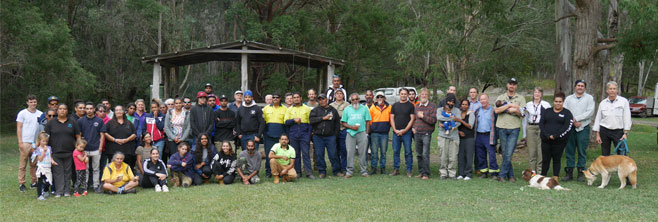
Minyumai IPA hosted the final Firesticks Partners Meeting on the 8-10th May. Rangers from Wattleridge, Ngunya Jargoon and Boorabee and the Willows IPAs (Indigenous Protected Areas) and rangers from Casino Boolangle and Gugin Guddaba Local Aboriginal Land Council (LALC) were joined by representatives from the Local Land Services (LLS), Office of Environment and Heritage (OEH), NSW Rural Fire Service (RFS), University of Technology Sydney and Nature Conservation Council (NCC) Firesticks staff, who all came together at Minyumai for the three day meeting.
Bandjalang elder Doug Wilson Welcomed the participants to Country in language to ensure the comfort of visitors and ancestors. An important protocol for Aboriginal people.
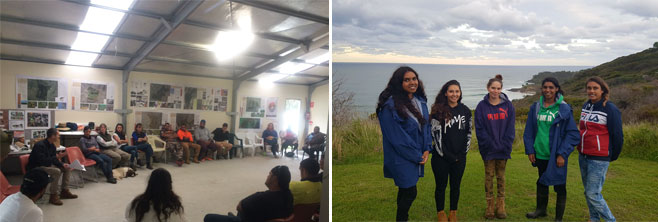
LHS Oliver Costello hosted a Firesticks Cultural Pathways Workshop on the first day. The Minyumai Doobai’s (women) rangers from left to right – Mary Wilson, Maitland Wilson, Lilly Wilson, Belinda Gomes and Emma Wilson at Goanna Headland on Cultural Values Tour.
Oliver Costello hosted a Firesticks Cultural Pathways Workshop on the first day. Some of the themes explored during the workshop included the importance of knowing where you come from and how you fit into the bigger picture of community, and looking after country. To finish the day a BBQ dinner was prepared by the Minyumai Doobai’s (women).
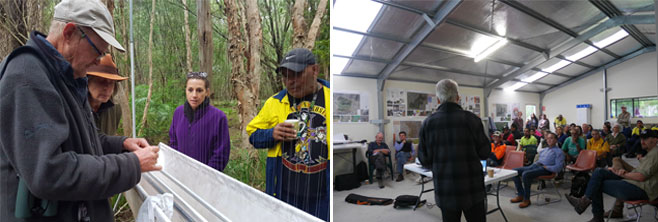
Firesticks ecologist David Milledge doing what he does best- identifying some of the threatened micro-bat species that rely on critical habitat at Minyumai IPA. Pest management expert Brad Nesbitt describing the opportunities and challenges of integrated feral animal management on the IPAs.
The second day started with a presentation from David Milledge the Firesticks Ecologist who recently completed 5 years of continuous systematic fauna monitoring across the 4 Partner IPAs – Minyumai, Ngunya Jargoon, Wattleridge and Boorabee and the Willows. The collection of long-term monitoring data is an integral part of demonstrating the significance of the IPAs for biodiversity conservation and the effectiveness of the management techniques being applied, and provides essential information for adaptive management.
Pest management expert Brad Nesbitt shared his work and results in assisting Minyumai, Boorabee and the Willows and Wattleridge IPAs in managing feral animals on their properties. Feral goats, pigs and wild (Ninja) cattle are destroying habitat and hindering the positive effects of fire and weed management by the rangers. An integrated management system is integral to help these systems recover.
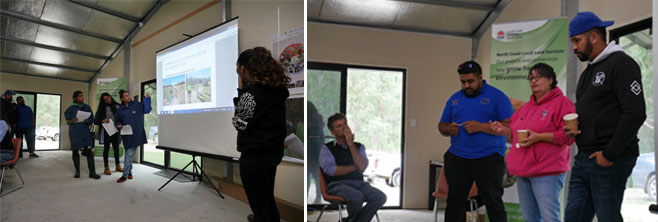
Minyumai IPA Doobai’s rangers present the results of the setaria trials to the group. Wattleridge IPA rangers Kane Patterson, Tremane Patterson and Manager of Banbai Development Aboriginal Corporation Tanya Elone talk about some of the achievements and challenges they have faced in managing their property.
Casino Boolangle rangers and Jim Morrison from the Northern Rivers Fire and Biodiversity Consortium (NRFABCON) explained the ongoing work restoring the riparian habitat at Busbys Flat and plans for the implementation of cultural burns to provide a mosaic of burnt and unburnt vegetation with some assistance by some of the more experienced rangers. The Minyumai Doobai’s explained the ongoing work at Minyumai IPA to restore native habitat that has been overtaken by the invasive pastoral grass setaria. The treatment includes the application of fire to the setaria grass which is then followed up with herbicide application to assist the native seed bank to germinate.
Wattleridge IPA rangers explained the challenges and successes they have encountered over the past few years in managing weeds particularly after the application of fire as well as monitoring the response of fire on their key iconic species the Backwater Grevillea and the Kukra- echidna. A presentation from Boorabee and the Willows IPA ranger Jayden Potter shared the success they have had in reducing the numbers of feral goats. He shared footage from the use of drones and explained how they are used in helping to monitor goat numbers across the difficult terrain of their property.
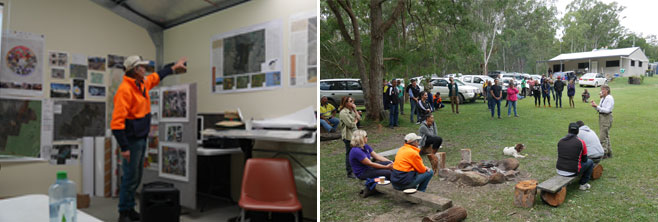
Gugin Guddaba LALC ranger Andrew Johnson explains the challenges and rewards encountered when working at the Hemet Range near Kyogle. Lynn Baker and Penny the conservation detector dog from OEH demonstrate their skills in locating feathers and scat from the threatened coastal emu.
The Helmet Range, owned by Gugin Guddaba LALC also has difficult terrain and the process of accessing their property and enhancing important Eastern Bristle Bird habitat was discussed by ranger Andrew Johnson. The cultural significance of the Helmet Range was shared, reinforcing the importance of these properties to the communities that are looking after them. The challenges of applying fire to the land at Ngunya Jargoon IPA showed that thinking outside of the box can create rewarding results. The rangers there used the Cultural Routine Agricultural Management Action (RAMA) pathway to apply fire in the form of small pile burns to protect the native cypress trees- Callitris, which are culturally significant to the community there.
After lunch Lynn Baker Senior Threatened Species Officer from the Office of Environment and Heritage (OEH) and Penny the conservation detector dog performed a demonstration which showcased Penny’s skills in finding emu feathers, eggs and koala scats. Lynn explained how important it is to trust the detector dog when working in the field. Damian Lett from the National Parks and Wildlife Service (NPWS) presented some of the ongoing work within the NPWS estate in co-operation with Aboriginal rangers in applying fire to country. Oliver Costello shared how the NPWS has developed a Cultural Fire Management Policy to use with community groups and the NPWS network. This will enable more community participation in cultural burning activities within the NPWS.
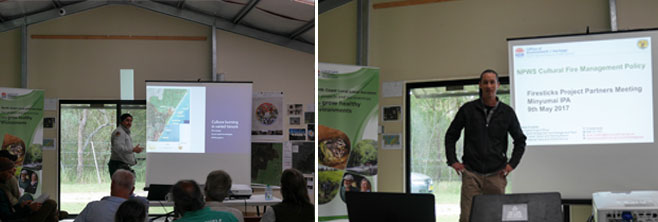
Damian Lett shares the good work Aboriginal rangers are doing with NPWS. Oliver Costello presents the NPWS Cultural Fire Management Policy.
Presentations were then delivered regarding recently finalised reports. Dr Noah Neilsen talked about the NCC Firesticks Participatory Evaluation Report, and Greg Banks from NCC delivered a summary of findings from the Cultural Burning in NSW: NCC Firesticks Experience Report. These reports will hopefully inform others who are working on similar projects about some of the challenges lessons we have learned in delivering the NCC Firesticks program over the last 5 years.
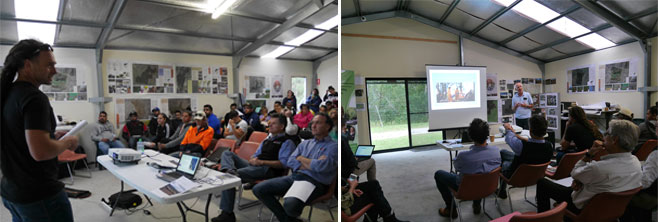
Dr. Noah Neilsen explains the results from the NCC Firesticks Participatory Evaluation Report. Greg Banks delivers the findings uncovered in the Cultural Burning in NSW: NCC Firesticks Experience Report.
The second day finished with a Cultural Values tour of the Evans Head area where Doug Wilson and Daniel Wilson shared stories and information about the significant areas that make up the broader cultural landscape around Minyumai IPA. It was deeply moving to have such insightful and interesting stories shared with the group and particularly valuable to understand the importance and connectivity of the broader landscape.
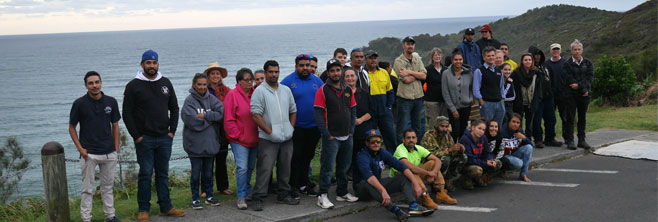
Finally on the last day Michelle McKemey and Lesley Patterson shared their WINBA=Fire Seasonal Calendar developed by the Banbai rangers from Wattleridge, as a part of Michelles PhD research. Miles Holmes shared the Seasonal Calendar developed in collaboration with the Ngunya Jargoon IPA rangers for the Jali lands near Wardell. These calendars are inspirational and informative, sharing information specific to the country they are from. A valuable education tool and wonderful way for the communities to rediscover and share special attributes of their country.
The NCC Firesticks Project would like to acknowledge Elders past and present and the Banbai, Ngoorabul and Bandjalang Nations for their ongoing hospitality, patience and interest in being part of this project. It certainly has had some challenges but we hope that we’ve collectively laid some strong foundations for continued recognition and support of the immensely significant cultural and biodiversity values of Aboriginal Lands in NSW. As the project draws to a close end of June we will continue to look at options for ongoing funding to continue this important work. Will keep you posted.
Many thanks to the Australian Government for funding.
Image credits: Richard Brittingham, Sian Hromek and Michelle McKemmey.

